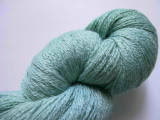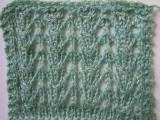 
Yarn Profile: Helen's Lace First Impressions
Her color combinations range from brilliant to bare whispers, with a small line of single colors that still carry subtle variations in hue. Although some catalogs and Web sites manage to represent her color range fairly well, you still don't get the full effect of her multicolored blends until you actually hold the skein in your hands. Opening a package of Lorna's Laces yarns for the first time is always exciting. Her lace-weight yarn carries the name of her grandmother, Helen, an impassioned lace knitter. It's a shimmery blend of wool and silk that comes in hefty 1250-yard skeins. For this review I used a single-color Sage. Knitting Up
Overall, I didn't encounter any major show-stoppers. Occasional small loose tufts of silk presented themselves along the surface of the yarn. If you like that effect, you could leave them. I don't, so I gently tugged them off. Blocking / Washing
The swatches readily took their blocked form, stretching to form a truly fluid, feather-light flat surface. The swatches can only stretch so far, however, so remember to cast on and off extra loose when knitting lace. As they dried, a faint halo of fuzz emerged along the surface of the swatches. With some yarns, this may not be a desired effect. For lace shawls, however, it adds a marvelous, cozy effect. Wearing
With normal friction, the swatches simply bloomed and softened more and more. Eventually a few tiny pills emerged, but the fibers were so short that I could easily pull them off without hurting the yarn beneath. The stitchwork and silk sheen covered up any signs of real wear. The bigger threat to Helen's Lace shawls are things like errant Velcro or rough spots on wooden chair backs. Particularly rough friction sped the deterioration process. The main victim appeared to be the silk, which rose to the swatch surface in fuzz and pills. The stitchwork itself remained in perfect form, however, helping conceal the wear. Conclusion
Helen's Lace varies from the competition for two main reasons. First, it's available in an enormous range of color blends, most of which you won't find anywhere else. And second, it combines wool and silk, whereas other lace-weight yarns tend to be pure wool. The wool gives strength, warmth, and elasticity, while the silk lends a gentle opalescent sheen to the finished fabric. The $44 per skein price can be hard to swallow. But keep in mind that you'll only need one skein for a sizeable shawl or two scarves. And if you're new to shawls, you can use the easy shawl pattern provided on the label's reverse side. |
Yarn name
Helen's Lace
Manufacturer
Lorna's Laces
Fiber content
50% silk 50% wool
Gauge
4 stitches per inch on US 8 needles, blocked for lace; 8 stitches per inch on US 3 needles
Average retail
price
$44/skein
Where to Buy Online
Heartstrings Fiber Arts
Weight/Yardage per Skein
Approx. 4 oz. / 1250 yards
Country of Origin
USA
Manufacturer's
suggested wash method
Hand wash in warm water. Rinse well. Dry flat.
Review date
7/18/2002
Color used in review
Sage (#43) |
Copyright © 2000-2016 Clara H. Parkes
All rights reserved. Permission to reproduce is required.
All rights reserved. Permission to reproduce is required.
